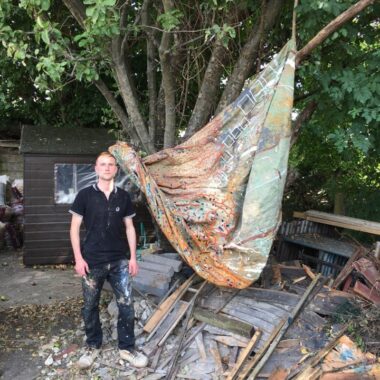Remembering The London Group members who served in The First World War.

Taken from Susan Haire’s President’s speech at the opening of The London Group Annual Exhibition, December 2018:
”With 2018 being 100 years after the First World War and having recently marked the centenary of the Armistice I thought it would be appropriate for us to remember The London Group members who served and the way in which the Group responded to the war.
The first London Group exhibition took place three months before the beginning of the war in March 1914. The Imperial War Museum collection contains works by 15 members who served in WW1. They were:
- David Bomberg, sapper, Royal Engineers, sent to the front shortly after getting married.
- Sydney Carline, pilot, Royal Flying Corps, shot down and wounded over the Somme but he survived.
- Frank Dobson, Artists’ Rifles.
- Jacob Epstein, Royal Fusiliers in the Ypres Salient.
- Henri Gaudier-Brezeska died in 1915 leading a cavalry charge in the French Army. He had little regard for his own safety and received a decoration for bravery before he died. He had just sent wonderfully evocative drawings to the second LG exhibition from the front.
- Charles Ginner, Royal Army Ordnance Corps and Intelligence Corps.
- Henry Lamb, medical officer, Royal Inniskilling Fusiliers. He was badly gassed in 1918.
- Bernard Meninsky, Royal Fusiliers.
- John Nash, Artists’ Rifles, went over the top in 1917. Out of 80 men all but 12 were hit in the first few minutes. He was one of the few survivors. His painting “Over the Top” is in the IWM.
- Paul Nash, also Artists’ Rifles, was in the Ypres Salient until invalided out in 1917, a few days later most of his unit were killed in an assault.
- CRW Nevinson, Friends’ Ambulance Unit on the Western Front and then RAMC in Wandsworth.
- William Roberts, Royal Field Artillery.
- Edward Wadsworth, as a naval dock officer and a Vorticist painter, supervised the dazzle camouflage painting of warships, so striking, like giant cubist sculptures at sea!
- HS Williamson, Kings Royal Rifle Corps was wounded at least twice while at the front.
- Percy Wyndham Lewis, officer, Royal Garrison Artillery in the Ypres Salient.
- Finally I would like to remember Harold Gilman, the well-respected first president, who died of Spanish Flu in 1919, transmitted by soldiers from the USA arriving in Europe to fight. His death was a great loss to the Group.

“The second London Group exhibition, in March 1915, saw brutal war images with Nevinson’s paintings of machine warfare, dispelling any myths of personal heroism. This was the exhibition where Epstein showed his famous Rock Drill and after the show he hacked the limbs off the figure to make Torso (Tate Collection) in protest of the mutilation, butchery and carnage of the war.
“When the devastation of war was reaching its peak with the Battle of the Somme, in 1916, The London Group lost its gallery where it had had its first five exhibitions. This was the Goupil Gallery in Regent Street and William Marchant, the gallery owner, gave the Group an ultimatum – he had decided to refuse to show conscientious objectors. At a special LG meeting it was unanimously agreed to reject his terms. This was a brave and highly principled decision because it risked rendering the Group homeless. In fact Mark Gertler and Adrian Allinson were conscientious objectors and later Duncan Grant was also. Luckily Sir Ambrose Heal of Heal’s in Tottenham Court Road came to the rescue and the Mansard Gallery on the top floor of the store became the home of The London Group for the next eight years. The first London Group exhibition there, in April/May 1917, the sixth LG exhibition, saw the controversy of Mark Gertler’s hugely provocative Merry-Go-Round expressing the frenzy of mechanised chaos.
“Only half the members showed in the third, fourth and fifth London Group exhibitions largely because of involvement with the war. The introduction of non-members to take part in the fourth LG show in June 1916 was a way of maintaining the numbers of exhibitors and this was the very first London Group Open. It certainly appears that non-member exhibitors helped keep the Group going during the war years. As the war dragged on to its end the Group was very depleted and dispirited and could easily have disbanded. It’s remarkable that it endured, managing to show regularly throughout the war. We can be grateful that it survived against such terrible odds enabling the Group to thrive today after 105 years.”
Susan Haire PLG, 2018 with thanks to David Redfern LG







